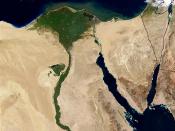The Nile, is the longest river in the world, and is located in northeastern Africa. Its principal source is Lake Victoria, in east central Africa. The Nile flows north through Uganda, Sudan, and Egypt to the Mediterranean Sea, with a total distance of 5584 km. From its remotest headstream in Burundi, the river is 6671 km long. The river basin covers an area of more than 3,349,000 sq km. Not only is the Nile considered a wonder by Herodotus, but by people all over the world, due to its impotance to the growth of a civilization.
The first great African civilization developed in the northern Nile Valley in about 5000 BC. Dependent on agriculture, this state, called Egypt, relied on the flooding of the Nile for irrigation and new soils. It dominated vast areas of northeastern Africa for millennia. Ruled by Egypt for about 1800 years, the Kush region of northern Sudan subjugated Egypt in the 8th century BC.
Pyramids, temples, and other monuments of these civilizations blanket the river valley in Egypt and northern Sudan.
To Egypt, the Nile is seen as the fountain of life. Every year, between the months of June and October, the great rivers of the Nile rush north, and flood the highlands of Etiopia. The flooding surges of the land, and leaves behind water for the people, and fertile land, which can be used for agriculture. The impact the Nile has on Egypt during the ancient times and present are consierably apparent. The influence the Nile has is so extensive, that even the speech is transposed. For example, "To go north" in the Egyption language is the same as, "to go down stream"; "to go south" the same as "to go upstream." Also, the term for a "foreign country" in Egypt would be...


